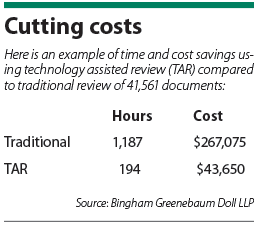Subscriber Benefit
As a subscriber you can listen to articles at work, in the car, or while you work out. Subscribe Now Barberio
Barberio Haller
Haller Christensen
ChristensenBy Margaret Christensen, Meaghan Klem Haller and Greg Barberio
Litigation matters have no shortage of topics for disagreement. But, the one undisputed issue is e-discovery is expensive. As companies and individuals increasingly store all documents in electronic format, the universe of data to consider in responding to discovery requests is growing exponentially, thus further increasing the cost of an already expensive and time-consuming process. One of our partners loves to warn that every day humans create 2.5 million terabytes of data. Or, to put it in perspective, 90 percent of the world’s data has been created in just the last two years.
While, on occasion, the substance of various drafts of a document are critical to the outcome of a dispute (such as the interpretation of an ambiguous contract), typically the various iterations of a document are never relevant to a dispute. Nevertheless, companies and individuals are not in the habit of purging drafts, copies and versions of less important documents, perhaps because they do not know what might later be deemed critical. More likely, however, they do not see the documents taking up physical space and therefore simply forget to deal with electronically stored information or data, or ESI. That might explain why many people have inbox folders related to matters that resolved more than a decade ago or have nearly a thousand or more unfiled emails. Were these documents or folders in hard copy, they almost certainly would have been addressed or destroyed under an appropriate document retention policy.
 The amount of ESI stored by clients contributes to the ever-increasing cost of discovery. Upon receipt of discovery requests, the receiving party should provide a copy of all potentially responsive ESI to its counsel, being sure to capture relevant servers, desktops and custodians. Counsel can then begin the Herculean task of determining responsiveness and privilege, a feat drastically simplified by uploading them all to a searchable database. Such a database not only aids in the review, but also allows counsel to track notes about the relevance, confidentiality and privilege of each document.
The amount of ESI stored by clients contributes to the ever-increasing cost of discovery. Upon receipt of discovery requests, the receiving party should provide a copy of all potentially responsive ESI to its counsel, being sure to capture relevant servers, desktops and custodians. Counsel can then begin the Herculean task of determining responsiveness and privilege, a feat drastically simplified by uploading them all to a searchable database. Such a database not only aids in the review, but also allows counsel to track notes about the relevance, confidentiality and privilege of each document.
Use of a database is nothing new. The difficulty comes when a massive number of personal emails, near-duplicates, drafts and other non-responsive junk happen to contain keywords used to identify documents as likely responsive. Likewise, broad discovery requests result in the production of documents that are of dubious value to the dispute to avoid being accused of withholding documents. This makes production more expensive for the producing party as well as the requesting party, who often bears the cost of reproduction. The cost to process documents to preserve metadata but ensure that it cannot be altered runs about 5 cents per page, the cost of a photocopy. Federal court rules provide some guidance (and pressure) to parties seeking electronically stored data, but litigants in state court are often left to reach a cost-sharing solution on their own. No matter the venue, most parties tend to agree that they want to reduce their share of discovery costs.
Recent advances in technology assisted review, or TAR, significantly reduce the time and cost to review data to cull responsive documents. TAR works like other predictive technology: the reviewing attorneys are assigned review sets of documents and mark them as responsive or nonresponsive. The database operators continue to assign review sets until the database can use the human review responses to predict which of the unreviewed documents are responsive. Then, counsel does a quality-control check to confirm the accuracy of the predictive review and finally must manually review any documents that could not be categorized by the predictive technology. The resulting time savings is incredible. The graphic illustrates an example of a 41,561-document review using a traditional versus a technology assisted review. (Special thanks to Q-Discovery for providing sample data based on real cases.)
The initial corpus of the documents was 903,154, and parties stipulated to date restrictions, targeted custodians and specific keywords to reduce the reviewable set to 41,561 documents. A traditional linear review of all 41,561 documents would require 1,187 hours, or 158 days. At a rate of 35 documents per hour at a billable rate of $225 hour, the cost of review alone would be $267,075. Using a TAR approach, the attorney only reviewed 6,798 documents in 194 hours or 26 days, at a cost of $43,650. This number can fluctuate depending how quickly the algorithm can learn the documents.
Typically, once counsel has identified the relevant and responsive ESI that will be produced, the documents are packaged for production. The requesting party, to search and review the documents, must also upload the files and any metadata into a database, essentially duplicating some of the labor. To minimize those costs, vendors can take out the formal production step. For instance, if there are 40,000 pages of responsive data, but the documents likely to see the light of day at a deposition or other proceeding amount to only 800 pages, it may be a waste of time and money to convert the documents to PDF or TIF files for production, particularly if the receiving party will simply turn around and put them back into a database. Rather, if the parties can work together (or if a court requires it), the responsive documents can be produced within the producing party’s database system thus saving substantial conversion costs.
The protocol for production within a database is relatively simple.
First, it must ensure that the accuracy and authenticity of the documents is protected. That is already achieved within any discovery database.
Second, the receiving party must not be able to see or review the documents that the producing party deemed non-responsive or privileged. The vendor can achieve this goal by creating a small database including just the subset of documents deemed responsive.
Third, the documents must be assigned some control number within the database so that there is no confusion as to which document is which.
Finally, if confidentiality is a concern, the parties must agree to maintain all documents in the produced database confidentially until otherwise agreed or adjudicated. Without such an agreement, the producing party would be required to formally produce each confidential document so that it can be stamped as confidential, defeating the purpose of the database production.
Ultimately, whichever party desires to use a document in a deposition or proceeding is responsible for ordering it from the discovery vendor. At that point, the producing party must support or remove any confidentiality designation. The parties could agree to split the cost of the formal production, or to each pay for those documents they plan to use. Either way, the cost is significantly less.
As the technology offerings in litigation support expand and become more user-friendly, there are countless options for decreasing discovery costs. Once entrenched in litigation, the best chance to manage costs is cooperation among the parties to use a common vendor and establish creative protocols.•
__________
• Margaret Christensen is a partner and Meaghan Klem Haller is an associate in the litigation group at Bingham Greenebaum Doll LLP. Greg Barberio is a litigation support analyst at BGD. Opinions expressed are those of the authors.
Please enable JavaScript to view this content.
